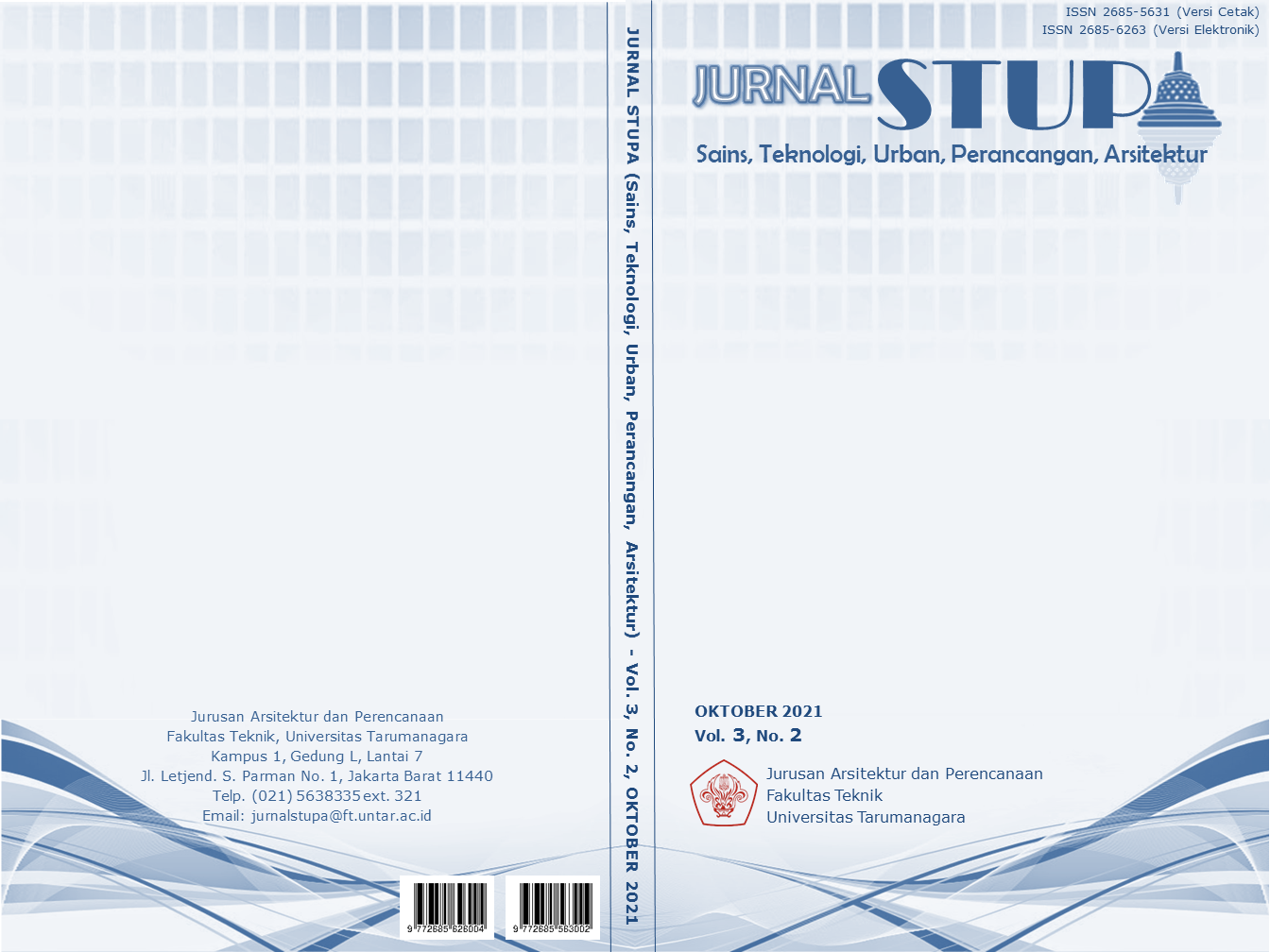HIVE CITY : KONSERVASI DAN WISATA PADA KAWASAN KECAMATAN CILEUNGSI BOGOR
Main Article Content
Abstract
Doomsday is a condition in which all the life of this world ends. Everything in this world is sure to end someday but this incident can happen much faster. Human neglect and greed in dealing with the surrounding ecology can accelerate the end of the world. This world is filled with various kinds of living things ranging in size from large to small, each creature has its own role and is related to one another. Currently 40% of the insect population is threatened with extinction and if the insects become extinct there will be a mass extinction of living things, this is called the Insect Doomsday. This can occur because insects play an important role in pollination, pest control, waste processing, and decomposers as well as a source of food in the ecosystem. This project uses the Biomimicry method which uses the geometric shape of the characteristics of the honeycomb. The resulting geometric shape becomes a metaphor for the insects to live in. The basic concept of this project is to create an open conservation that can increase the bee and butterfly population in the Cileungsi Area and become a place for insects that have lost their food sources due to changes in the function of the green area. Rapid action is needed to prevent the decline in insect populations in order to prevent the Insect Doomsday. The authors designed the project on the basis of Beyond Ecology. With conservation projects and insect tourism, it can increase insect populations and increase biodiversity by using horticulture that uses insects to develop its plants.
Keywords: Insect Doomsday; Conservation; Beyond Ecology
Abstrak
Kiamat adalah sebuah kondisi dimana seluruh kehidupan dunia ini berakhir. Segala sesuatu di dunia ini pasti suatu saat akan berakhir akan tetapi kejadian ini bisa terjadi jauh lebih cepat. Kelalaian dan ketamakan manusia dalam berhubungan dengan ekologi sekitar dapat mempercepat akhirnya dunia. Dunia ini diisi dengan berbagai macam makhluk hidup mulai dari ukuran besar sampai kecil, setiap makhluk mempunyai perannya masing-masing dan saling berkaitan. Saat ini 40% populasi serangga terancam punah dan jika serangga punah maka akan terjadi kepunahan masal makhluk hidup, inilah yang disebut dengan Kiamat Serangga. Hal tersebut dapat terjadi karena serangga memegang peran penting dalam penyerbukan, pengontrol hama, pengolah limbah, dan decomposer serta sumber makanan dalam ekosistem. Proyek ini menggunakan metode Biomimikri yang menggunakan bentuk geometri dari karakteristik sarang lebah. Bentuk Geometri yang dihasilkan menjadi metafora tempat tinggal para serangga. Konsep dasar dari proyek ini adalah menciptakan sebuah konservasi terbuka yang dapat menambah populasi serangga lebah dan kupu-kupu di Kawasan Cileungsi serta menjadi tempat bagi serangga yang kehilangan sumber makanan akibat perubahan fungsi kawasan hijau. Diperlukan aksi cepat dalam mencegah penurunan populasi serangga dalam mencegah Kiamat Serangga penulis merancang proyek dengan basis Beyond Ecology. Dengan proyek konservasi dan wisata serangga dapat menambah populasi serangga serta menambah keanekaragaman hayati dengan hortikultura yang menggunakan serangga dalam mengembangkan tumbuhannya.
Article Details
References
Cohen, J. J. (2015). Stone an Ecology for Inhuman. London
Bartlett School of Architecture. (2017). Design Anthology PG11. Https://Issuu.Com/Bartlettarchucl/Docs/Design_Anthology_Unit11
Bitar. (2021). Pengertian, Tujuan, Manfaat Dan Jenis Konservasi Serta Contohnya. https://www.gurupendidikan.co.id/konservasi/#ftoc-heading-4
Eliyani. (2010). Penentuan Lokasi Pasar Induk Kabupaten Bogor Berdasarkan Perkembangan Wilayah Dan Aksesibilitas. Bogor: Sekolah Pasca Sarjana Institut Pertanian Bogor
Gissen, D. (2010). Territory: Architecture Beyond Environment.
Hamid, A. (2019). Kecamatan Cileungsi dalam Angka 2019. Bogor: BPS Kabupaten Bogor
Harvey, J. A. (2020). International scientists formulate a roadmap for insect conservation and recovery. https://www.nature.com/articles/s41559-019-1079-8.
Hidayatullah, M. S. (2021). Vertical Farming: Pertanian Modern Sebagai Solusi Lahan Sempit. https://persmacanopy.com/vertical-farming-pertanian-modern-sebagai-solusi-lahan-sempit/
Lydia, K. (2010). EcoRedux Design Remedies for an Ailing Planet. Vol. 80 No. 6.
Pranadji, T. (2005). Pengelolaan Serangga Dan Pertanian Organik Berkelanjutan Di Pedesaan: Menuju Revolusi Pertanian Gelombang Ketiga Di Abad 21. Bogor
Rutecka, A. (2014). Architectural Design As A Result Of Scientific Research. New Definition of Architecture. Polandia: Wroclaw University of Technology
Samways, M. J. (2017). Insect Conservation for the Twenty-First Century. https://www.intechopen.com/books/insect-science-diversity-conservation-and-nutrition/insect-conservation-for-the-twenty-first-century.
Subdirektorat Statistik Hortikultura. (2018). Statistik Tanaman Buah-Buahan Dan Sayuran Tahunan Indonesia. Bps-Statistic Indonesia
Suparwoko dan Betri T. (2017). Urban Farming Construction Model On Vertical Building Evelope To Support The Gree Buildings Development In Sleman, Indonesia. Yogyakarta
Sutanto, A. (2020). Peta Metode desain. Jakarta: E-book
Widhiono, I. (2015). Strategi Konservasi Serangga Pollinator. Purwokerto: Universitas Jenderal Soedirman.
Reynolds, S. (2019). What happens to the natural world if all the insects disappear? The Conversation.
https://theconversation.com/what-happens-to-the-natural-world-if-all-the-insects-disappear-111886



